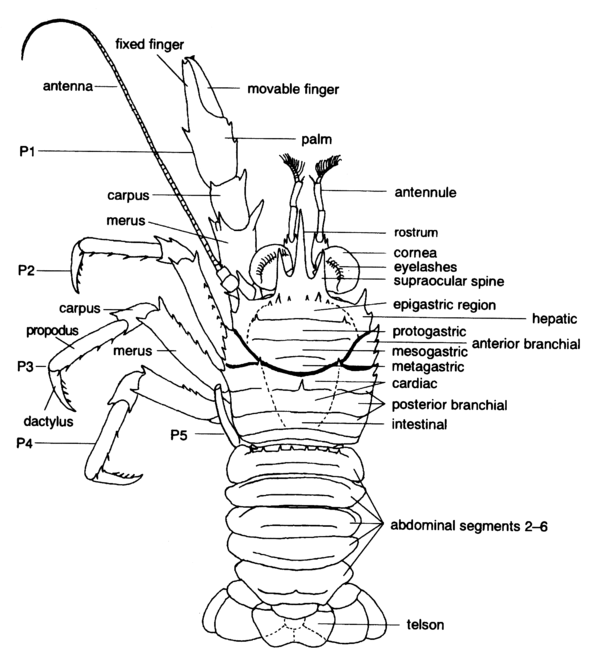( ) [Baba, 2005].
) [Baba, 2005].
 ) [Baba, 2005].
) [Baba, 2005].Entire animal, right appendages omitted, dorsal view, based on Munida. [Baba, 2005]
Last somite of body, bearing arms and commonly caudal furca or pair of cerci, growth zone for postcephalic somites located at its anterior edge. (Syn. postabdomen, style (Archaeostraca)) [Moore and McCormick, 1969].
Plate attached medially to terminal segment of abdomen [Poore, 2004].
Postsegmental plate or lobe bearing anus [Brusca and Brusca, 2002].
Terminal (posterior) portion of abdomen; caudomedian element of "tail fan" (see Figs. 13, 14) [Hobbs and Jass, 1988].
Terminal appendix attached to the sixth (terminal) abdominal segment and not considered as a true segment. See: abdomen [Ingle, 1983].
Terminal portion of body (not considered to be true somite), usually bearing anus, sometimes with caudal furca. (Syn. postsegmental region, style) [McLaughlin, 1980].
Terminal somite of abdomen [Williams, 1984].
Terminal somite of the body which is always fused to pleonite 6 to form the pleotelson [Holdich and Jones, 1983].
Terminal unit of the abdomen bearing the anus (Fig. 1, 3D) [Perez Farfante and Kensley, 1997].
The median tail of a crustacean [Mauchline, 1984].
The terminal (posterior) unit of the abdomen [Hobbs, Hobbs, and Daniel 1977].
The terminal part of the body which bears the anus; it articulates with the last (6th) abdominal segment [Warner, 1977].
The terminal segment of a crustacean's body, bearing the anus. In most isopods, the telson is fused to the anterior pleonite [Wilson, 1989].
The terminal segment of the abdomen [Chace and Hobbs, 1969].
The terminal somite of abdomen; part of tail fan [Butler, T.H.].
(Order Cladocera):
Postabdomen [Stachowitsch, 1992].
(Order Notostraca):
Last segment of body; bears anus and pair of elongate caudal rami. (with/without supra-anal plate) [Stachowitsch, 1992].
(Order Diplostraca):
Last segment of body; directed ventrally and bears pair of terminal anal spines as well as pair of caudal rami. Bears anus and is therefore occasionally termed anal segment or anal somite (in which case terminal lobe is interpreted as representing telson). Number of dorsal spines and position of forked filament are of taxonomic importance [Stachowitsch, 1992].
(Order Anostraca):
Last segment of body; bears pair of caudal rami. Bears terminal anus and therefore occasionally termed anal somite [Stachowitsch, 1992].
(Class Cephalocarida):
Last segment of body (20th postcephalic segment) with ventral comb and pair of caudal rami. Bears terminal anus and therefore occasionally termed anal segment or anal somite [Stachowitsch, 1992].
(Order Cumacea):
Posteriormost segment of body. May be fused to last (sixth) abdominal somite (pleonite) to form pleotelson. May bear anus and thus be divided into preanal and postanal parts. (free, fused; elongate, short; pointed, semicircular, truncate; with/without apical spines) [Stachowitsch, 1992].
(Order Tanaidacea):
Posteriormost segment of body. May be fused to last (sixth) or to fifth and sixth abdominal somites (pleomeres) to form pleotelson [Stachowitsch, 1992].
(Order Decapoda):
Posteriormost segment of body (although not considered to be a true somite). May form tailfan together with uropods and bears anus ventrally. (single element, several elements; rectangular, rounded, spiniform, styliform, subquadrangular, subrectangular, subtriangular, subtruncate, triangular; tip: acuminate, rounded, subacute, truncate; armed: laterally serrate, with carina, with median groove, with movable spines, with spines, with spinules) [Stachowitsch, 1992].
(Order Amphipoda):
Posteriormost, relatively small segment of body. Shape is of taxonomic importance, (fleshy, laminar; entire, emarginate = bilobed = cleft; acute, rounded; naked, setose, spinose) [Stachowitsch, 1992].
(Order Isopoda):
Terminal part of the body, usually bearing the anus [Kensley and Schotte, 1989].
(Order Isopoda):
Terminal segment of body, typically fused with one or more abdominal segments (pleonites) to form pleo-telson. (lanceolate, ovate, pointed, with sub-parallel margins; posterior margin: concave, convex) [Stachowitsch, 1992].
(Order Mysida):
Terminal segment of body. Forms tailfan together with uropods and bears anus vantrally [Stachowitsch, 1992].
(Order Stomatopoda):
Well-developed posterior most segment of body (although not considered to be a true somite); may be fused with sixth abdominal somite (pleomere) to form pleotelson. Dorsal surface typically sculptured with various carinae, margins bearing prelateral lobes and numerous teeth and denticles. (armed, smooth) [Stachowitsch, 1992].
(Subclass Mystacocarida):
Last segment of body with telsonic combs ventrally, supra-anal plate posterodorsally, and caudal furca. Bears anus ventrally and therefore occasionally termed anal somite [Stachowitsch, 1992].
(Class Ostracoda):
Anal somite [Stachowitsch, 1992].
(Class Remipedia):
Anal segment [Stachowitsch, 1992].
(Superorder Syncarida):
Terminal segment of body. Forms tailfan together with uropods an anaspidacean, bears rudimentary caudal furca in stygocaridacean, and is fused with last (sixth) abdominal somite to form pleotelson in bathynellacean [Stachowitsch, 1992].
(Order Thermosbaenacea):
Posteriormost segment of body. May be fused to last (sixth) abdominal somite (pleomere) to form pleotelson [Stachowitsch, 1992].
(Order Euphausiacea):
Narrow and pointed posteriormost segment of body. Forms tailfan together with appendages (uropods) of sixth (last) abdominal somite. Typically bears pair of posterior subapical spines [Stachowitsch, 1992].
Crustacea glossary. Natural History Museum of Los Angeles County. 2011.